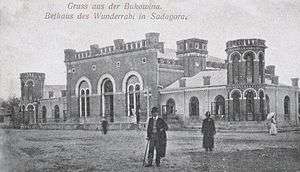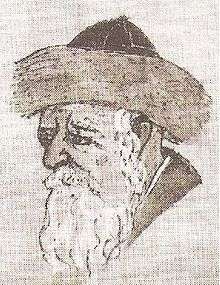Sadigura (Hasidic dynasty)
Sadigura is a Hasidic dynasty named for the city of Sadhora (Sadigura in Yiddish), Bukovina, which belonged to Austria.[1] The dynasty began in 1850 with Rabbi Avrohom Yaakov Friedman, a son of Rabbi Yisrael Friedman of Ruzhyn, and was based in Sadigura until 1914. During the interwar period the dynasty was led by Rebbes in Vienna and Przemyśl, Poland, and on the eve of World War II was transplanted to Israel, where it thrives to this day.

Sadigura is one of the branches of the Ruzhiner dynasty, together with Bohush, Boyan, Chortkov, Husiatyn, and Shtefanesht.
As of 2013, Sadigura has several hundred members in Israel and Europe. Its members reside in Israel in Jerusalem, Ashdod, Modiin Ilit, Beitar Ilit, and Elad, and in Europe in London and Antwerp.[2] The dynasty is centered on the current Sadigura Rebbe's beis medrash in Bnei Brak, Israel.
The 6th Rabbi, Rabbi Yisrael Moshe Friedman 65 was nifter in Bnei Brak on 11 August 2020 following an lengthy illness.
History
Leadership in Austria
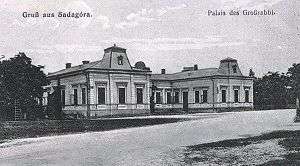
In the early 1840s, the Ruzhiner Rebbe fled Russia to escape persecution by the Tsar. He moved his family to Sadigura.[1] The Ruzhiner Rebbe lived in Sadigura for ten years; he built a palatial residence and an imposing synagogue, and attracted tens of thousands of Hasidim.[3][4] When the Ruzhiner Rebbe died at the age of 54 on 9 October 1850,[5] his six sons established their own courts in different towns. His eldest son, Rabbi Sholom Yosef Friedman (1813-1851),[6] remained in Sadigura to continue leading the court his father had founded, but died ten months later.[7] At this point, the Ruzhiner Rebbe's second son,[6] Rabbi Avrohom Yaakov (1820–1883), assumed the mantle of leadership in Sadigura, becoming known as the first Sadigura Rebbe.[8]
The Sadigura Rebbe maintained the grand lifestyle of his father's court, with its lavish accoutrements and showy dress, and immersed himself in the mysticism of Kabbalah, as had his father. The combination of earthly royalty and spiritual depth attracted both Jews and Christians to his court.[9] Hundreds of thousands of Jews sought his wisdom and counsel.[10] He also entertained visits from prominent Christians, including princes, counts, and writers who published articles about him in newspapers in Vienna, Berlin, Frankfurt, Prague, and other locales.[11]
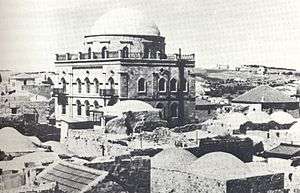
The Sadigura Rebbe undertook the remainder of the fund-raising for the Tiferet Yisrael Synagogue, the Ruzhiner synagogue in the Old City of Jerusalem initiated by his father. The synagogue was completed in 1872.[12][13] He also purchased the privilege of lighting the main bonfire at the grave of Rabbi Shimon bar Yochai in Meron, Israel on Lag BaOmer from the Sephardi guardians of Meron and Safed. The Sadigura Rebbe bequeathed this honor to his eldest son, Rabbi Yitzchok, the first Boyaner Rebbe, and his progeny.[14]
After his death, his two sons, Rabbi Yitzchok (1850–1917) and Rabbi Yisrael (1852–1907), assumed joint leadership of their father's Hasidim. While they were content with this arrangement, many of the Sadigura Hasidim preferred to have one Rebbe, and in 1887, the brothers agreed to draw lots to determine who would stay in Sadigura and who would move out. The lots fell to Rabbi Yisrael to remain as the second Sadigura Rebbe, while Rabbi Yitzchok moved to the neighboring town of Boiany (Boyan) and established his court there, becoming the first Boyaner Rebbe.[15]
Rabbi Yisrael had five sons: Rabbi Aharon of Sadigura (the author of Kedushas Aharon) (1877–1913) who had considerable musical accomplishment,[1] Rabbi Shlomo Yosef of Chernovitz, Rabbi Avrohom Yaakov Friedman of Sadigura (1884–1961), Rabbi Yitzhak of Rimanov (1887–1929),[1] and Rabbi Shlomo Chaim (Reb Shlomenu) of Sadigura (1887–1972).[16] After Rabbi Yisrael's death in 1907, each of his sons became Rebbes, making their courts and conducting their tishen in different halls of the great Sadigura synagogue.[17] Rabbi Yisrael's eldest son, the Kedushas Aharon, died in 1912[7] and was succeeded by his 16-year-old son, Rabbi Mordechai Sholom Yosef Friedman.[18]
In 1914, with the outbreak of World War I, Rabbi Avrohom Yaakov fled to Vienna together with his younger brother, Rabbi Shlomo Chaim, and his orphaned nephew, Rabbi Mordechai Sholom Yosef. Rabbi Avrohom Yaakov established his court in Vienna and led the Sadigura Hasidim from that city for the next 24 years.[7][19] The relocation of the Sadigura Rebbes to Vienna spelled the end of the once flourishing Jewish community in Sadigura, which comprised more than 5,000 Jews before World War I. Although some Jews remained, only a few lone survivors were left at the end of World War II .[7]
Leadership in Israel
Rabbi Avrohom Yaakov Friedman, grandson of the first Sadigura rebbe, obtained a visa to Palestine shortly after the Anschluss of 1938 and re-established his court in Tel Aviv.[20] Thousands of Sadigura Hasidim were murdered in the Holocaust, leaving the Rebbe with only a few dozen followers. Nonetheless, he continued to lead his Hasidim with princely bearing,[21] conducting his court in Tel Aviv for 22 years until his death in 1961.[22] Known as the third Sadigura Rebbe, Rabbi Avrohom Yaakov was actively involved in Jewish communal life in the new state of Israel, being one of the first members of Agudat Israel and occupying a seat on the Moetzes Gedolei HaTorah.[21]
After the death of the third Sadigura Rebbe in 1961, his Hasidim asked his younger brother, Rabbi Shlomo Chaim, to succeed him, but the latter demurred. He did agree to sit in his brother's place at tischen held on Jewish holidays and on the yahrtzeits of his Ruzhiner and Sadigura ancestors.[23] Meanwhile, the Sadigura dynasty continued through the Rebbe's nephew, Rabbi Mordechai Sholom Yosef Friedman (1897–1979), known as the fourth Admor of Sadigura,[2] who led Sadigura Hasidim in Sadigura and Przemyśl (where he founded the Yeshiva ‘Meshivas Nefesh’) before emigrating to Tel Aviv in 1939. His words of Torah were compiled in ‘Knesses Mordechai’.[7] Upon his death in 1979, Rabbi Mordechai Sholom Yosef was interred near the other Admorim of Sadigur, in the ‘Nachlas Yitzchak’ cemetery in Givatayim,[7] and was succeeded by his son, Rabbi Avrohom Yaakov Friedman (1928–2013), who moved the Sadigura court from Tel Aviv to Bnei Brak.[2] Rabbi Avrohom Yaakov died at 84 on 1 January 2013, after being ill from pneumonia, and was buried in the Nahalat Yitzhak cemetery alongside his father.[2] He was succeeded by his only son, the present Sadigura Rebbe, Rabbi Yisrael Moshe Friedman (b. 1955), former av beis din (head of the rabbinical court) of Sadigura in London.
Rabbi Yisrael Moshe Friedman 65 was nifter in Bnei Brak on 11 August 2020 following an lengthy illness. [24]
On the yahr tzeit of the holy Rizhiner on the third day of the Jewish month of cheshvan in 2016, the current Rebbe rededicated the Rizhiner Kloiz in Sadigura. The Rebbe was accompanied to Sadigura, Ukraine with roughly 400 of his followers. This was the culmination of a few year project of restoration on the Klolz's interior. The actual outer structure, is the one the holy Rizhiner oversaw himself during most of its construction.The blue prints of the Kloiz, were approved by the holy Rizhiner. Much input was added by him. The interior was restored to mimic its original appearance.
http://hamodia.com/2016/11/10/sadigura-rebbe-trip-kivrei-tzaddikim-ukraine/http://www.jdn.co.il/gallery/762277
Lineage of the Sadigura dynasty
| |||||||||||||||||||||||||||||||||||||||||||||||||||||||||||||||||||||||||||||||||||||||||||||||||||||||||||||||||||||||||||||||||||||||||||||||||||||||||||||||||||||||||||||||||||||||||||||||||||||||||||||||||||||||||||||||||||||||||||||||||||||||||||||||||||||||||||||||||||||||||||||||||||||||||||||||||||||||||||||||||||||||||||||||||||||||||||||||||||||||||||||||||||||||||||||||||||||||||||||||||||||||||||||||||||||||||||||||||||||||||||||||||||||||||||||||||||||||||||||||||||||||||||||||||||||||||||||||||||||||||||||||||||||||||||||||||||||||||||||||||||||||||||||||||||||||||||||||||||||||||||||||||||||||||||||||||||||||||||||||||||||||||||||||||||||||||||||||||||||||||||||||||||||||||||||||||||||||||||||||||||||||||||||||||||||||||||||||||||||||||||||||||||||||||||||||||||||||||||||||||||||||||||||||||||||||||||||||||||||||||||||||||||||||||||||||||||||||||||||||||||||||||||||||||||||||||||||||||||||||||||||||||||||||||||||||||||||||||||||||||||||||||||||||||||||||||||||||||||||||
Image gallery
 Interior of the hasidic synagogue in Sadhora
Interior of the hasidic synagogue in Sadhora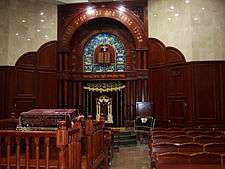 Interior of the new Sadigura Beis HaMedrash in Bnei Brak
Interior of the new Sadigura Beis HaMedrash in Bnei Brak
See also
| Wikimedia Commons has media related to Sadigura (Hasidic dynasty). |
- History of the Jews in Poland
- History of the Jews in Galicia (Central Europe)
- History of the Jews in Ukraine
References
- Alfassi, Itzhak (2008). "Ruzhin, Israel". Jewish Virtual Library. Retrieved 15 December 2011.
- Ettinger, Yair (1 January 2013). "Hasidic leader Yaakov Friedman, the Admor of Sadigura, dies at 84". Haaretz. Retrieved 2 January 2013.
- Friedman, Yisroel. The Golden Dynasty: Ruzhin, the royal house of Chassidus. Jerusalem: The Kest-Lebovits Jewish Heritage and Roots Library, 2nd English edition, 2000, p. 15.
- Wein, Berel (1990). Triumph of Survival: Story of the Jews, 1650-1990. Mesorah Publications, Ltd. p. 93. ISBN 0899064981. (footnote 24)
- Assaf, David (2002). The Regal Way: The life and times of Rabbi Israel of Ruzhin. Stanford University Press. p. 170. ISBN 0804744688.
- Friedman, The Golden Dynasty, p. 20.
- Meringer, Motty (31 August 2009). "The Sadigur Chassidic Court". Tog News. Archived from the original on 2 May 2015. Retrieved 9 January 2013.
- Friedman, The Golden Dynasty, pp. 15–17.
- Ewen, Isaac. "The Golden Dynasty: Rebbe of Sadeger", in The Golden Tradition: Jewish Life and Thought in Eastern Europe, Lucy S. Dawidowicz, ed. Syracuse University Press, 1967, pp. 195–196. ISBN 0815604238
- Friedman, The Golden Dynasty, pp. 21.
- Friedman, The Golden Dynasty, pp. 30–31.
- Brayer, Rabbi Menachem (2003). The House of Rizhin: Chassidus and the Rizhiner dynasty. Mesorah Publications. pp. 260–263. ISBN 1-57819-794-5.
- Friedman, The Golden Dynasty, pp. 11–12.
- Rossoff, Dovid (2005). קדושים אשר בארץ: קברי צדיקים בירושלים ובני ברק [The Holy Ones in the Earth: Graves of Tzaddikim in Jerusalem and Bnei Brak] (in Hebrew). Jerusalem: Machon Otzar HaTorah. pp. 315–316.
- Friedman, The Golden Dynasty, p. 76.
- Friedman, The Golden Dynasty, pp. 20, 37.
- Friedman, The Golden Dynasty, p. 37.
- Friedman, The Golden Dynasty, pp. 54–57.
- Friedman, The Golden Dynasty, pp. 38–39.
- Friedman, The Golden Dynasty, p. 39.
- Friedman, The Golden Dynasty, p. 41.
- "Nothing But the Unadorned Truth". Hamodia. 2010. Retrieved 9 January 2013.
- Friedman, The Golden Dynasty, p. 46.
- Ronen, Gil (1 January 2013). "Sadigura Rebbe Passes Away". Arutz Sheva. Retrieved 9 January 2013.
Further reading
- Leo Bruckenthal. Geschichte der Juden in der Bukowina ("History of the Jews in Bukovina"), Hugo Gold: Tel Aviv, 1962, pp. 98–105.
